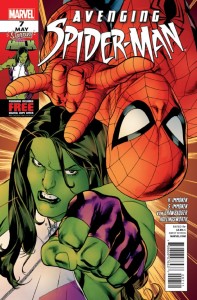 I must admit I’ve been dragging my heels on this review of Deathstroke #9 all week. I’ve been pretty clear about my feelings on the subject of Rob Liefeld’s take over of Deathstroke. Liefeld certainly has his fans and his detractors. While I wouldn’t go so far as to say I’m in the “I Hate Rob Liefeld” club, we here at the Crisis On Infinite Midlives home office have been more than willing to use Liefeld’s name as an easy punchline, the same way Tim Allen might make grunting noises into a microphone instead of telling an actual joke. But, honestly, in the 90s, if I was looking for ridiculously silly, overblown art, I read The Tick. At least the silly had a purpose in that. Liefeld has never done much for me art wise. However, I’ve never read his actual writing. I’m aware he’s created a number of characters for which such comics luminaries as Alan Moore have written spectacular stories. I mean, he must know what he’s doing if he keeps staying employed in the business and Alan Moore has played in his sandbox, right? Or does he just have some incriminating photos of Bob Harras somewhere?
I must admit I’ve been dragging my heels on this review of Deathstroke #9 all week. I’ve been pretty clear about my feelings on the subject of Rob Liefeld’s take over of Deathstroke. Liefeld certainly has his fans and his detractors. While I wouldn’t go so far as to say I’m in the “I Hate Rob Liefeld” club, we here at the Crisis On Infinite Midlives home office have been more than willing to use Liefeld’s name as an easy punchline, the same way Tim Allen might make grunting noises into a microphone instead of telling an actual joke. But, honestly, in the 90s, if I was looking for ridiculously silly, overblown art, I read The Tick. At least the silly had a purpose in that. Liefeld has never done much for me art wise. However, I’ve never read his actual writing. I’m aware he’s created a number of characters for which such comics luminaries as Alan Moore have written spectacular stories. I mean, he must know what he’s doing if he keeps staying employed in the business and Alan Moore has played in his sandbox, right? Or does he just have some incriminating photos of Bob Harras somewhere?
After reading Deathstroke #9, I’m inclined to believe it’s the latter.
Read all about Deathstroke and his new playdate, Lobo, after the jump!









 Podcast RSS Feed
Podcast RSS Feed iTunes
iTunes Google Play
Google Play Stitcher
Stitcher TuneIn Radio
TuneIn Radio Android
Android Miro Media Player
Miro Media Player Comics Podcast Network
Comics Podcast Network